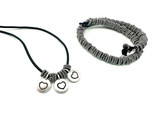Gemstone Index: Tiger Eye
Richly striped tigereye is a variety of quartz with a fine luster. These semiprecious beads are available in their natural, unenhanced brown-gold state, and sometimes in heat-treated blue or red. Also known as African cat's eye, crocidolite, and tiger's eye, this gemstone contains oriented fibers of crocidolite (a mineral of the amphibole group) that have been replaced by silica. The fibers are twisted or crumpled instead of straight, reminiscent of sand and sunlight. Tigereye is also vitreous (hard, unbendable and glass-like). With its strong chatoyance, the gemstone gets its name from its resemblance to the eye of a tiger.
Other "eye" quartzes exist as well, and their names depend only on their background colors and reflections: Green-gray stones are called cat's-eye; blue-grey to bluish varieties are called hawk's-eye; and deep brown stones are called bull's-eye or ox-eye. As with all gems, protect tigereye from scratches and sharp blows. Also avoid large temperature changes. Because of its chatoyance, tigereye should not be cleaned with alcohol or abrasives; however, it can be helpful to treat the stone with oils like Goo Gone.
The stone has previously been called "griqualandite," named after Griqualand West in Africa, where the best tigereye was once found.
We occasionally also have Tiger iron. Tiger iron jewelry components may include tiger iron beads and donut pendants. This semiprecious gemstone is a natural mixture of hematite, jasper, and tigereye, and it provides the perfect example of a metamorphosed gemstone.
More than two billion years ago, deposits of the three separate materials were slowly mashed together as tectonic plates shifted. The tremendous pressures on the original crystals resulted in the intricate, banded designs that tiger iron components display.
Each separate gemstone can be distinctly seen in layers of gold, silver, brown and red, drawing unique vertical and horizontal patterns. This unusual trinity stone is believed to carry the metaphysical energies and attributes of its three parents.
Our Bead Blog
-
Simply Springy 2-Hole Bracelet
Apr 28th 2025Designed by: Guest Designer Deb Floros Suggested Supplies 1 #61-840-50-01 Beadalon Cord, WildFire,
-
Exotic Statement Necklace
Apr 28th 2025Designed by: Guest Designer Deb Floros Suggested Supplies 1 #88-400-003-5 58x50mm Pewter Connector,
-
Rubber Tubing Necklace and Memory Wire Bracelet Set
Mar 21st 2025Designed by: Guest Designer Deb Floros Suggested Supplies 1 #61-622-02 2mm Rubber Cord, Bulk, for J



